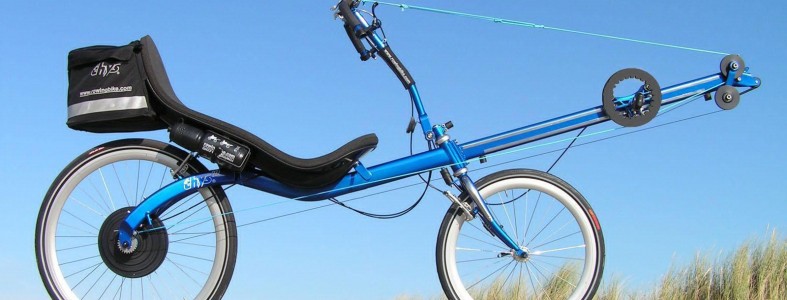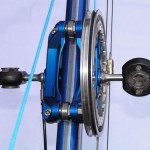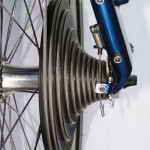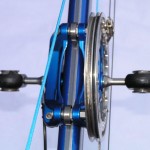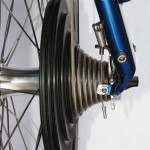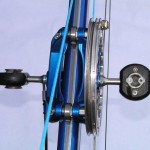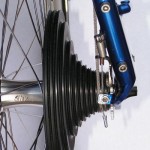Thys 222 Revolver
The THYS 222 is sold out and this model is not being produced anymore (for the time being?). Parts remain available as for all earlier THYS rowingbikes.
After more than two years of CVT shifting system the THYS 222 Rowingbike is updated again. The new version is called THYS 222 Revolver due to the rotating gear ring.
The Revolver system has evolved from the CVT system and resembles a lot. The efficient way of shifting gears has remained the same: there’s one clutch button, operated with the right hand thumb.
Making a stroke while pushing the button results in a lower gear. Making a recovery stroke with the button pushed down the result is a higher gear.
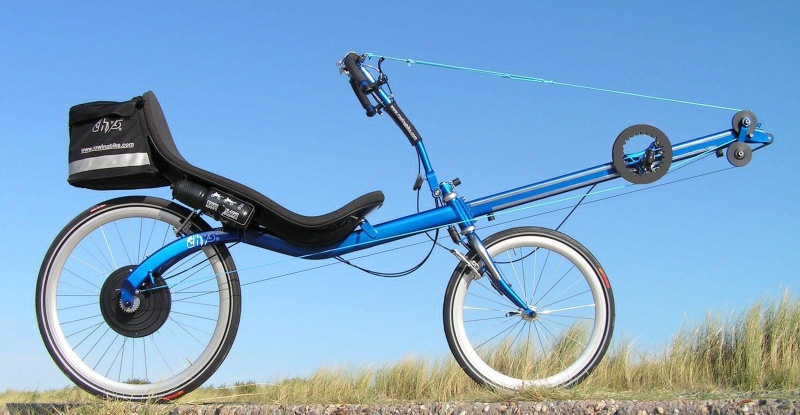
The gear range
Range 178 mm snek: Minimal 245 centimeters covered for each stroke up to a maximum of 927 cm. This is a range of 378%.
For heavy alpine conditions a 220 mm Snek is an option: minimal 196 cm covered centimeters for each stroke with the same maximum of 927 cm. This is a range of 472%.
Advantages of the Revolver system
- The weight of the whole propulsion system has decreased with 502 grammes. When riding with the Dyneema® propulsion cable the weight reduction is even 686 grammes. The average lifespan of the Dyneema® propulsion cable is under dry weather conditions approximately 1100 km. During bad weather (sand, mub and dirt on the cable and Snek), the lifespan decreases.
- The lifespan of the (steel) propulsion cable is at least doubled compared to the CVT. (Only one test resulting in breaking the cable is accomplished: it took Richard Bruijn more than 9000 km).
- Assembling an even larger mountain Snek is now possible: 220 mm is already available.
- The new synthetic Snek is easy to replace by the owner of the rowingbike.
- The light weight Dyneema® armstroke cable (13 grammes) is fit with a sliding knot which enables you, even during riding, to adjust the length.
- Shifting gears is limited, it’s not possible to shift to a too high or too low gear.
- If you want to take a spare cable with you: the Dyneema® version weighs just 19 grammes.
- De locking mechanism is uncomplicated and less sensitive for repeated adjusting than the cable clamp on the CVT.
- Lighter and more ergonomic brake and shifting handles.
- Very easy to exchange rear tyre because of easy unhooking the returncable from the Snek.
Disadvantages
- When using the Dyneema® propulsion cable the shock cord needs to be tightened incidentally. (The Dyneema® “crawls”, a form of very slow stretching).
- Theoretically the Revolver doesn’t have the Continuous Variable Transmission, but in fact the more than one hundred gear steps are so small that there’s no difference noticeable.
Technical details
- The weight gain in the propulsion system makes the propulsion more efficient. The mass of the forward and backwards going parts needs to be accellerated and stopped again in every stroke. Especially when riding with a high stroke rate, which normally occurs during climbing and sprinting, this mass is a rather important aspect.
- Snek and bow pulleys are made of lightweight synthetic materials in stead of aluminium. The handle bar is equipped with lighter brake handles and a handy gear button above the handle bar.
- In stead of the cable clamp (the wedge housing) at the CVT version, there’s a gear ring around the foot slider. This ring is actually a drum with a left and a right side.
- At the right side the shock cord (55 grammes) can be wound up and off.
- Apart from the steel CVT cable (170 grammes), also a 3 mm dyneema cable (19 grammes) can be applied as a propulsion cable. The lifespan of the dyneema cord is significant: 1100 km. If you reverse the cable in time the lifespan is doubled. Only the part that runs along the Snek wears out.
Uncomplicated operation
- The ring is normally locked and can be unlocked by means of the clutch button which simultaniously blockes the Snek. By blocking the Snek also the propulsion cable and return cable is blocked. The picture below shows the locking mechanism of the gear ring.
- If you move the foot slider backwards (of forward) while pushing the clutch button, the propulsion cable is wound on (or unwound from) the gear ring, by which more (or less) propulsion cable is left on the Snek. This results in a higher (or lower) gear.
Different gears
- Low gear
- Low gear
- Medium gear
- Medium gear
- High gear
- High gear
The gear ring can be locked at 24 positions per revolution. At the 178 mm Snek it needs almost 4.5 revolutions to go from the lowest to the highest gear. Therefore you have more than one hundred gears. Strickly spoken it’s no longer a CVT (Continuous Variable Transmission), but this can’t be noticed in everyday experience. Each step is so small that the familiair smooth feeling lasts!
Weight reductions
- The 222 Revolver with Dyneema® propulsion cable economizes on cables, Snek and gear system almost 700 grammes on forward and back moving parts, compared with the CVT.
- With a steel CVT propulsion cable the weight reduction is still more than 500 grammes.
Tightening the system
After assembling the system needs to be tightened one or more times. In the beginning the twined Dyneema® and the knots in it need to set, resulting in a somewhat greater length. The return elastic can compensate quite a lot of difference in length, but there is an end to this. In this case simply shorten the cord slightly. Dyneema® tends to “crawl”. After a longer time (approximately six months) you might need to shorten the system again. You can shorten it simply by hooking the shock cord into another hole of the Snek. For larger adjustments you can shorten it at the ring or choose another hole for the shock cord.
In the gear ring are, at equal intervals, six mounting points for the return shockcord. They enable the rider to make personal adjustments for gear range.




